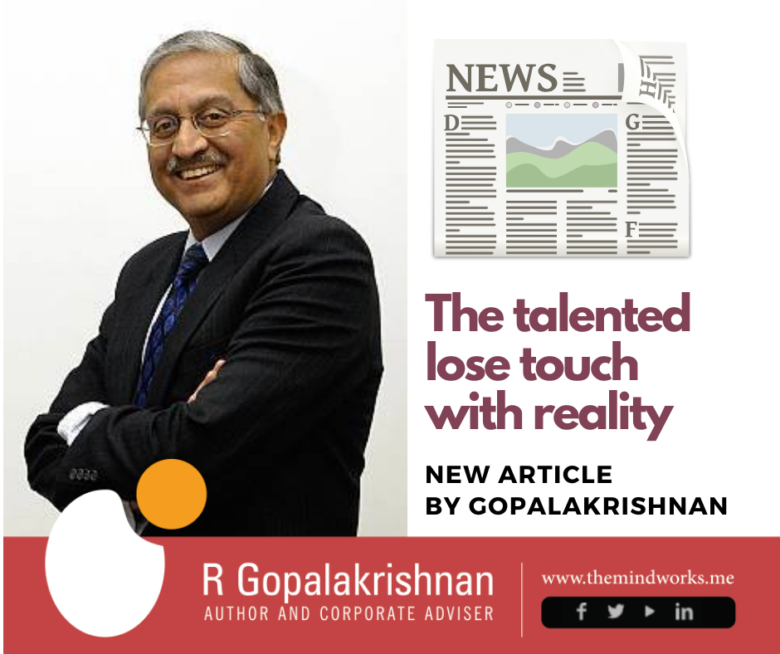Draft dated 10-7-22
TNIE (26)
To appear on 14-7-22
‘Transforming organizations’: a series in New Indian Express.
Transformation experiences at Unilever
By R Gopalakrishnan
(The writer is an author and business commentator. His articles and videos can be accessed on his website www.themindworks.me and his email ID is rgopal@themindworks.me)
(Self-evident lessons are the ones that leaders tend to forget during transformation management. Enterprise leaders can learn and practice the skills of an anthropologist–observe, listen, record, and reflect—all, without judgement.)
In my June column, I mentioned that I would share my personal experiences on organizational transformation from Unilever Arabia between 1990 and 1994 (integrating eleven joint ventures) and from Brooke Bond Lipton India Limited between 1994 to 1998 (integrating eight acquisitions). I feel encouraged that some readers have responded with enthusiasm and anticipation.
In the interests of brevity, I propose to view the experience through a conceptual rather than an operational lens. The learnings may appear like motherhood statements. In my defense, I affirm that the self-evident lessons are the ones that leaders tend to forget during transformation management. It is useful to learn and practice the skills of an anthropologist, viz, to observe listen, record, and reflect, all without judgement!
I recall that I had memorized a mantra to guide my daily routines—SCUPT—standing for Socialization–Communication–Understanding–Patience–Trust. This mantra was the outcome of a program that I attended at INSEAD, Fontainebleau on how to get the best out of diversity. There are five lessons to embellish the SCUPT mnemonic.
In most transformations, the bottleneck, or Crux as academic Richard Rumelt calls it, is adaptiveness of the team. In summary, the true value of an HR professional as a key ally is palpable during transformations.
Lesson1: Recruit early and make the HR chief as an ally: Colin Davie, an upcoming Scotsman in Unilever, was my first recruit as HR chief in Unilever Arabia. RR Nair, an accomplished professional, was already the HR chief in BBLIL—Brooke Bond Lipton–at the time of my joining the company. I had deep conversations with both the HR chiefs; they were incredibly valuable in helping me appreciate the song behind the words I heard. Meetings with them sometimes took precedence over other colleagues, whereas CEOs naturally tend to prioritize marketing, operations, and finance. I emphasize that while operational functions possess a natural gravitas, the CEO must accord a special focus to the HR function while implementing a transformation.
Lesson 2: Interact with the least powerful people in the ecosystem: I used to travel to distant and less visited operations to connect with factory and salespeople. It was strenuous, but worthwhile–Gizan, Tabuk, Gassim in Unilever Arabia and Tundla, Kanhan, Ghatkeshwar, and Etah in BBLIL. I learnt about the deep-rooted suspicions between Lipton India managers and Brooke Bonders, arising out of 80 years of head-on competition. In Arabia, the Lipton teabag business earned so much of the Unilever Arabia’s cash flows that the Lipton people silently disapproved of its reinvestment that cash in ‘the dud business of detergents’! Reach out and listen carefully for the subtle messages from out there.
Lesson 3: Formalize mechanisms for feedback about how things are: While informal methods of listening by leadership are important, the informal is not a substitute for the formal. In BBLIL, the HR chief, RR Nair, began an extended series at the Training Centre, branding it as Confluence Series. Almost 25 sessions were held, each session hosting 30-40 managers for an evening. RR Nair and I attended every session, thus connecting with about 1,000 executives. I learnt that merging balance sheets is easier than aligning mindsets. In Arabia, whenever I travelled, Colin Davie invariably arranged a lunch or formal communication meeting with the local managers in Bahrain, Kuwait, Dubai, Riyadh and so on. For me, these sessions were crucial. I had to train myself to listen to people without judging them—not very easy in a hierarchical organization.
Lesson 4: Use the burning platform to stimulate change: A delicate balance is required between imparting a sense of urgency for change and avoiding doom among the executives. There was a continuous tussle between the advocates of continuity and those for change. Consultation with the HR chief and early experimentation were both fabulously valuable. I was a fiend for feedback from my HR chiefs after every communication session to the point of appearing vulnerable!
It is good to remember that the HR chief is the only professional to whom the CEO can express personal vulnerability without creating organization-wide doubts about the leadership confidence. Luckily, my colleagues were frank about how the session could have been more effective. In Arabia, Unilever Arabia began just after the Saddam invasion of Kuwait, a war that began and concluded within three months. Times were stressful for Unilever managers to consider expatriation to the territory. In BBLIL, the Narasimha Rao-Manmohan Singh government had introduced liberalization. The measures threw up issues of cost benchmarking and competitiveness. The personal trauma for long-standing managers was intense. Their self-image was of established competence, yet, to see the mirror and accept glaring deficiencies was a challenge.
Lesson 5: Communicate constantly, but both ways: I learned that a CEO should never get tired of explaining the same thing repeatedly—without showing irritation or impatience. This is not easy for a pushing, tireless CEO, who is usually also in a hurry. Patience and understanding are essential. My perception at that time was that the advice of both my HR chiefs acted like soft brakes on a speeding automobile, metaphorically representing my leadership. They advised me about my own deficiencies in leading the company effort. I was gently reminded of a paradoxical Korean proverb that it is precisely when you want to speed up that often you must slow down.
In closing, I must add that the challenge of leading the transformation was not just mine but shared with a highly engaged and committed team of my corporate leadership team.


